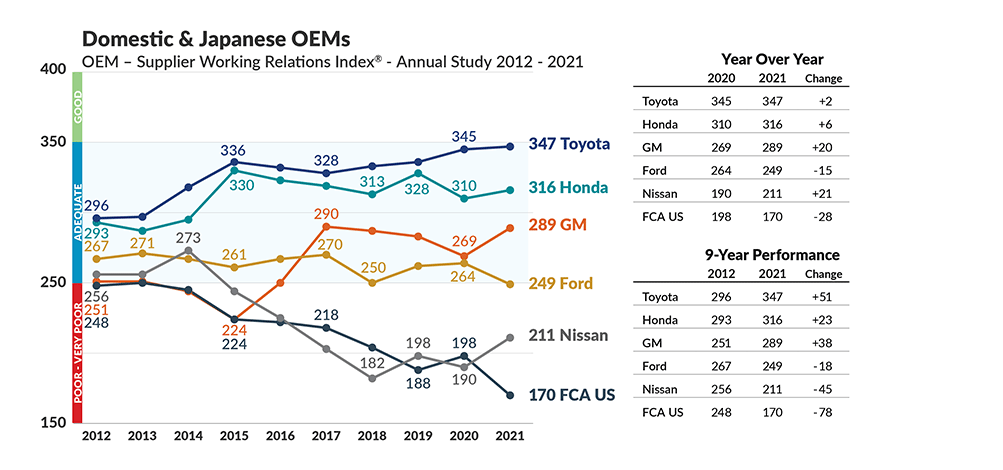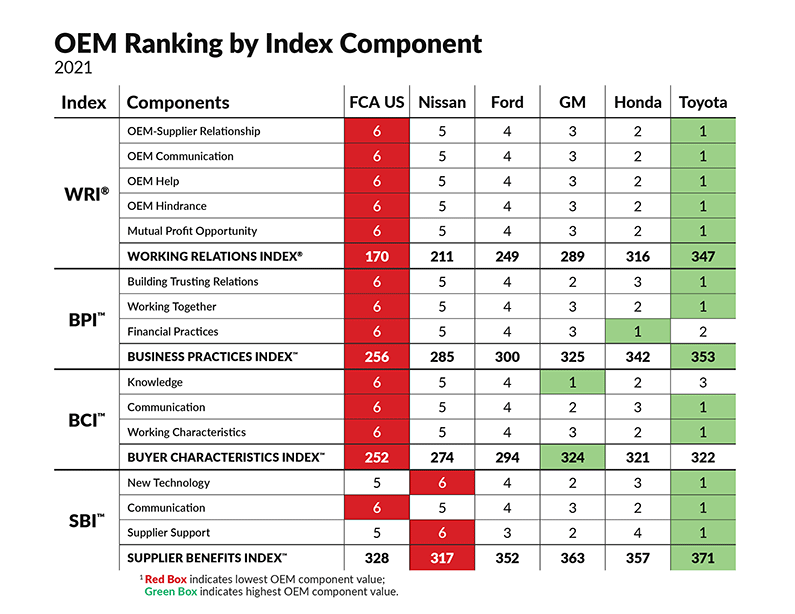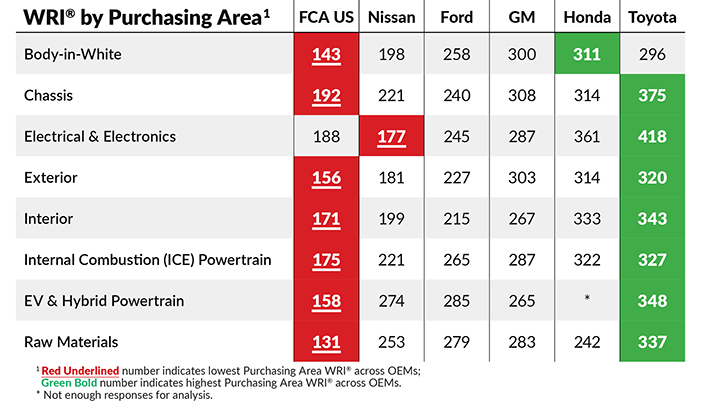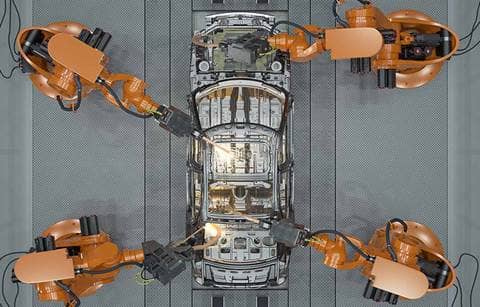Supplier relationships significantly influence the automotive industry’s competitive dynamics, especially in uncertain times. The annual Plante Moran Working Relations Index® Study measures the annual changes in and rankings of the quality of vehicle manufacturer (OEM)–tier-one supplier relationships, and the 2021 WRI® Study results are in. We break down key findings and what they mean to competitiveness.
Why OEM–supplier relationships matter to competitiveness
Three recent examples help illustrate how OEM–supplier relationships impact competitiveness: allocation of constrained resources, technology commercialization, and cost competitiveness. Let’s take a look:
Resource constraints
The continuing COVID-19 crisis as well as microchip and material shortages, have tested every major vehicle manufacturer and supplier, bringing just-in-time production philosophies and regionalization into focus. Lower per-piece prices can be a smart tradeoff for improved supply chain resilience and lower risk, giving OEMs more latitude and options to respond to challenges, current and future alike.
We all want to be the “customer of choice”—so much so that the phrase has become a platitude. But in times of crisis, when production allocation, response time, and stability in your supply chain are crucial, being the customer of choice helps you protect production and launches. Put another way, think of the working relationship with your suppliers, who determine how to allocate technical talent, capital, and other constrained supplies among their customers, as insurance. Without a doubt, when we look at the production disruptions over the past 15 months, it’s evident strong customer-supplier relationships make a difference.
Technology commercialization
As the industry moves aggressively toward electrification, purchasing groups must manage two sides of the transition equation, gearing up electric vehicle (EV) supplies for production while simultaneously moving out of internal combustion engine (ICE) production. Many suppliers supporting OEM ICE production also supply the electrification side. As OEMs shift their business from ICE to EV, as they take away and add programs, the customer–supplier working relationship becomes even more critical.
Cost competitiveness
Put simply, friction at the interface of the OEM–supplier relationship is waste, a non-value add, and it applies both to financial and time budgets. OEMs that rank higher on the WRI index benefit from greater supplier transparency around cost models and realistic cost reductions. Candidly, there’s less game-playing, which in turn minimizes expense. This is particularly important given the unstable production environment we’ve seen during the pandemic.
Communication drives the WRI
A primary component of the Working Relations Index® and ability to leverage customer–supplier interactions for competitive advantage is communication. With the pandemic came a tremendous increase in the frequency of communications between customers and suppliers, spurred by repeated plant shutdowns and restarts as well as microchip and materials shortages.
How much of the added communication will stick post-pandemic? Time will tell. No doubt, greater communication comes with a cost (time). That said, virtual communications don’t add travel cost, and the industry has seen that, for the most part, it can work through crises in a virtual world. The ability to have multiple functions present in the (virtual) meeting room—from both the customer and supplier side—certainly aided communications. Everyone heard the same thing; no one had to wait to get (or not get) the memo. This type of vertical and horizontal alignment can accomplish a lot.
Key findings from the 2021 WRI® Study
Each of the three OEMs that ranked the highest in 2021—Toyota, Honda, and GM—increased their WRI® score from last year, separating themselves from the other three competitors in the study (Ford, Nissan, and FCA US). Among the six OEMs, GM and Nissan increased their WRI score the most—GM by 20 points and Nissan by 21. The gains were driven by improvements in buyer characteristics (knowledge, communication, working characteristics) and business practices (building trusting relations, working together, financial practices).

The WRI® Study comprises four indices: Working Relations (WRI), Business Practices (BPI), Buyer Characteristics (BCI), and Supplier-Derived Benefits (SBI). When looking at the building blocks of each, Toyota and Honda ranked number one or two across every variable, which gives them momentum to remain at the top.

When we look at WRI scores by purchasing area, Toyota and Honda again lead. Toyota controls the top rankings by suppliers in electrical & electronics, EV & hybrid powertrain, and raw materials, with Honda number two in these areas. As the industry moves towards higher electronic content in interiors and EV powertrains, these two OEMs are best positioned to leverage their supply bases for competitive advantage.

In addition, Toyota’s top rank in all but one purchasing area shows the company is consistent across its groups. Many suppliers source into multiple purchasing groups per OEM, and consistency lowers the cost to serve any one customer.
Applying WRI results
The 2021 WRI® Study tells us three things. First, traditional purchasing paradigms must evolve if companies want to improve their competitive dynamics. The pace of the EV technology transition as well as business uncertainty and market pressure for affordable mobility services demand this. Leverage, commercial terms, and supplier interchangeability that traditionally have been part of ICE component purchasing? Going away. “Business as usual” will change.
Second, business-to-business trust is and will continue to be defined by accountability, information sharing, and realistic expectations—on both sides. Doing what you say you’ll do, transparency, and making reasonable asks will be critical to improving competitiveness, and this must be promoted from the top down.
Third, applying WRI® factors enlarges the number of strategic options OEMs have when faced with an increasingly uncertain business environment. When volumes and timelines are sure things, you can write contracts and your suppliers can ship to them. But when technologies and programs shift, when plants shut down and restart and shut down again, relationship quality, as measured by the degree of trust and communication, comes to the fore.
Fruitful customer-supplier relationships depend on trust—defined by accountability, information sharing, and realistic expectations. The OEMs that thrive in the future will be the ones able to weave these building blocks—rather than merely per-piece price—into competitive advantage.





